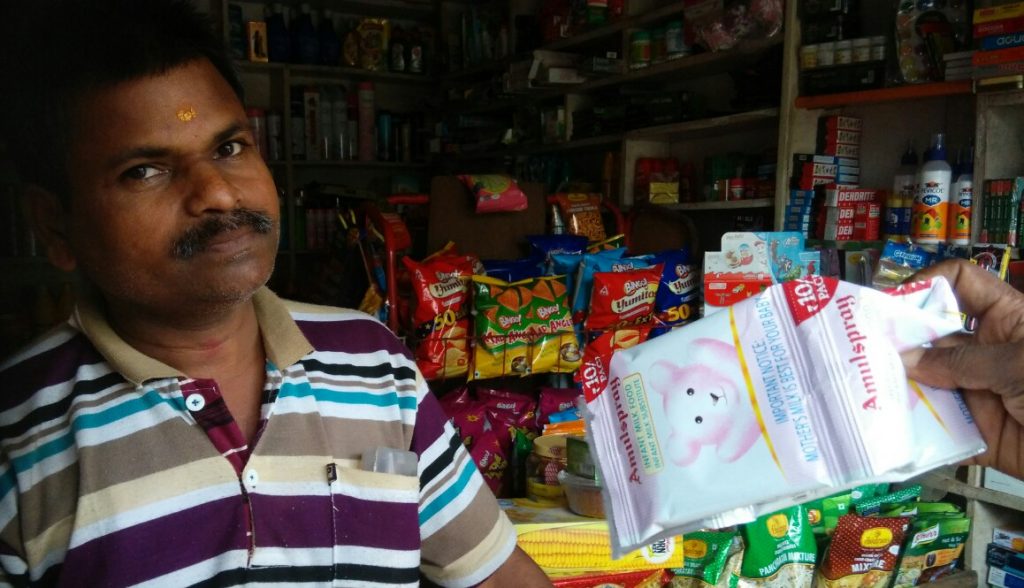Can business as usual impact nutrition: Need for developing focused business strategies
Authors: Rohit Parasar and Bhavani RV (MSSRF)
India has a high prevalence of under-nutrition despite consistent economic growth in recent years; agriculture remains a major livelihood activity and direct source of food for a large section of the population. Dependence on the market for sourcing some or all food has increased in developing countries across the globe; an analysis of agri-food value chains with a nutritional lens assumes importance in this scenario. Following a country review of about 40 initiatives of agri-food value chains linked to nutrition, we undertook an in-depth qualitative assessment of selected value chains. The potential of business to enhance consumption of nutritious food at the ‘base of pyramid (BoP)’ is examined here by analysing the value chain of Amulspray – a fortified milk powder, in the state of Odisha in east India.
Amulspray, a product of the Amul cooperative was introduced in the market in the early 1960s as a food for infants and young children. With a presence of over five decades, the product has an entrenched brand value and goodwill across the country; it has also helped address the deficit of milk production in eastern India. Currently, Amulspray is available in a variety of packages ranging from 1000 grams to smaller affordable packs priced at INR 10/- and INR 5/- (USD 1= INR 67.8). Interviews with actors at different points of the value chain and with consumers revealed that the smaller packets are available in remote interior locations of the state. Amul has effectively linked with the traditional system of small and informal businesses in the food value chain for retail outreach. The availability of affordable packs to households at the BoP may not however ensure consumption by the target group, i.e. children.

Credit: Lansa
Until and a decade and a half ago, Amulspray was a popular infant and child food in the market; but now it is largely used as a dairy whitener with tea and in preparation of kheer, a popular Indian dessert. In meeting these two major demands, Amulspray has been competing quite successfully with other brands of dairy whiteners and packaged liquid milk in the market, rather than with other milk products targeting children. While other brands have gained substantial market share in the child food segment, Amulspray is actually the lowest priced product among them; the average consumer is also very much aware of Amulspray being a product that can be fed to infants and young children, as the quote below from a retail shop owner reveals:
“All kind of households buy Amulspray. The product is well segmented; INR 10/- packs for lower income group, 500 grams and 1000 grams packets for mid and higher income group... People from villages buy Amulspray for their children, they buy other brands as well but those brands are not always available within the village...”

Credit: Lansa
However, with increasing presence and market share of other brands, Amulspray is no longer preferred as a food for consumption by children except by the lowest economic groups, particularly in rural areas. This segment accounts for only a fraction of total demand for the product and does not drive the sales; however it represents a nutritionally vulnerable section. At another level, it is observed that the influx of liquid milk in the market has significantly affected the volume of sales and margins of powdered milk manufacturers in India. But Amul, being a cooperative of dairy farmers, is not in a position to reduce its procurement price in line with falling global prices.
While these challenges will impact the sustainability of the value chain of Amulspray in longer run, it may not necessarily result in substantial business loss for the Amul cooperative per se as it has a diversified range of milk products like liquid milk (tetra and ordinary pack), butter, buttermilk, flavoured milk, ice-creams and chocolates. But the collapse of the Amulspray value chain will certainly impact on children at the BoP who rely on the product for their consumption of milk.
An immediate question is, how and why has the challenge surfaced for Amulspray? One reason is the inability of Amulspray to reach out to new-generation mothers, given the ban on promotion and advertisement of infant foods, in keeping with WHO guidelines. Covert and overt marketing of products to enlarge market share by other brands of child food products is another challenge.
Amulspray presents an interesting case of linking the value chain of a modern business network with traditional food value chain players and thereby increasing the potential to reach low income households in both rural and urban areas. Being the product of a cooperative business, both consumers and producers at the BoP are benefited by the value chain. Given its reach, this modern business value chain has the potential to retain the nutrition thrust by repositioning the product and facilitating informed choices by consumers at the BoP; it is a pointer that nutrition-focused businesses have to develop sustainable strategies specifically targeting BoP.
The study is part of ongoing research under the UK Aid Funded research programme consortium Leveraging Agriculture for Nutrition in South Asia (LANSA)